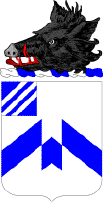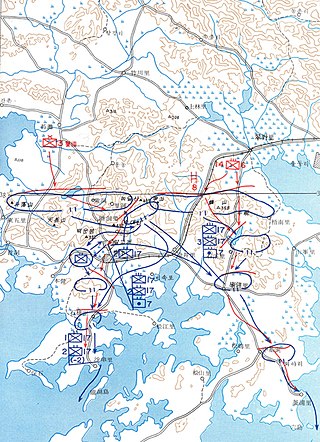
A battalion is a military unit, typically consisting of up to one thousand soldiers commanded by a lieutenant colonel and subdivided into a number of companies, each typically commanded by a major or a captain. The typical battalion is built from three operational companies, one weapons company and one headquarters company. In some countries, battalions are exclusively infantry, while in others battalions are unit-level organisations.
A company is a military unit, typically consisting of 100–250 soldiers and usually commanded by a major or a captain. Most companies are formed of three to seven platoons, although the exact number may vary by country, unit type, and structure.

Jäger is a German military term referring to specific light infantry units.

The King's African Rifles (KAR) was a British Colonial Auxiliary Forces regiment raised from Britain's East African colonies in 1902. It primarily carried out internal security duties within these colonies along with military service elsewhere during the world wars and other conflicts, such as the Malayan Emergency and the Mau Mau uprising. The regiment's enlisted soldiers were drawn from the native Africans, while most officers were seconded from the British Army. During the 1960s, as part of the decolonisation of Africa, more African officers were commissioned into the regiment before it was gradually disbanded. KAR battalions would go on to form the core of newly established armed forces throughout East Africa.

Permesta was a rebel movement in Indonesia that was declared on 2 March 1957 by civil and military leaders in East Indonesia. Initially the center of the movement was in Makassar, which at that time was the capital of the province of Sulawesi. However, support for the movement in South Sulawesi gradually dissipated, forcing the headquarters to move to Manado in North Sulawesi.

The Royal Malay Regiment is the premier unit of the Malaysian Army's two infantry regiments. At its largest, the Malay Regiment comprised 27 battalions. At present, three battalions are parachute trained and form part of the Malaysian Army Rapid Deployment Force. Another battalion has been converted into a mechanised infantry battalion while the remaining battalions are standard light infantry. The 1st Battalion Royal Malay Regiment acts as the ceremonial foot guards battalion for the King of Malaysia, and is usually accompanied by the Central Band of the Royal Malay Regiment. As its name suggests, the regiment only recruits ethnic Malays.

The Battle of Pasir Panjang, which took place between 13 and 15 February 1942, was part of the final stage of the Empire of Japan's invasion of Singapore during World War II. The battle was initiated upon the advancement of elite Imperial Japanese Army forces towards Pasir Panjang Ridge on 13 February.

Glider infantry was a type of airborne infantry in which soldiers and their equipment were inserted into enemy-controlled territory via military glider. Initially developed in the late 1930s by Germany, glider infantry units were used extensively during World War II but are no longer used by any modern military.
Reconnaissance, surveillance, and target acquisition (RSTA) groups the tasks of reconnaissance, surveillance and target acquisition conducted by the Department of Defense. RSTA supports military operations at a strategic, operational, or tactical level, either by dedicated RSTA forces or those which possess the capability.

The Marine Corps of the Republic of Indonesia , previously known as the Commando Corps of the Indonesian Navy, is an integral part of the Indonesian Navy and is sized at the military corps level unit as the naval infantry and main amphibious warfare force of Indonesia. The Marine Corps is commanded by a two-star Marine Major General.

The 1st Malaya Infantry Brigade was a regular infantry brigade formed in 1939 with its headquarters in Singapore immediately after the outbreak of hostilities in Europe. The Brigade participated in the Battle of Singapore against the Japanese until the surrender of the garrison in February 1942.

Sukabumi Regency is a regency (kabupaten) in southwestern Java, as part of West Java province of Indonesia. The regency seat is located in Palabuhan Ratu, a coastal district facing the Indian Ocean. The regency fully encircles the administratively separated city of Sukabumi. Covering an area of 4,164.15 km2, the regency is the largest regency in West Java and the second largest regency on Java after the Banyuwangi Regency in East Java. The regency had a population of 2,341,409 at the 2010 census and 2,725,450 at the 2020 census; the official estimate as at mid 2023 was 2,802,404, with a large proportion of it living in the northeastern part of the regency that encircles Sukabumi City, south of Mount Gede. A plan to create a new regency, the putative North Sukabumi Regency, is currently waiting for the approval of the central government, which has been deferred until the end of the current morotorium on new creations of regencies.

Military Regional Command III/Siliwangi is an Indonesian Army Regional Military Command that covers Banten and West Java province.

The Battle of Gang Toi was fought during the Vietnam War between Australian troops and the Viet Cong. The battle was one of the first engagements between the two forces during the war and occurred when A Company, 1st Battalion, Royal Australian Regiment struck a Viet Cong bunker system defended by Company 238 in the Gang Toi Hills, in northern Bien Hoa Province. It occurred during a major joint US-Australian operation codenamed Operation Hump, involving the US 173rd Airborne Brigade, to which 1 RAR was attached. During the latter part of the operation an Australian rifle company clashed with an entrenched company-sized Viet Cong force in well-prepared defensive positions. Meanwhile, an American paratroop battalion was also heavily engaged in fighting on the other side of the Song Dong Nai.

The 81st Division was formed under British control during the Second World War. It took part in the Burma Campaign.

The 1st Squadron, 75th Cavalry Regiment is a United States Army cavalry squadron established in 2004. It is the Reconnaissance, Surveillance and Target Acquisition Squadron (RSTA) squadron of the 2nd Brigade Combat Team "Strike" ♥, 101st Airborne Division. It performs reconnaissance and cavalry missions in support of that brigade.

The 30th Infantry Regiment is a United States Army infantry regiment. It was originally constituted 2 February 1901 in the Regular Army as the 30th Infantry. It was organized 12 February – 19 August 1901 at Fort Logan, Colorado, at the Presidio of San Francisco, California, and in the Philippines.

The Battle of Ongjin Peninsula was a series of battles that occurred in Ongjin Peninsula between 25 and 26 June 1950 and was a part of the Operation Pokpung and Operation Western Region that marked the beginning of the Korean War. On 25 June, the Korean People's Army Ground Force (KPAGF) 3rd 38-Guard Brigade, reinforced with the 1st Infantry Regiment of the 6th Infantry Division, launched a surprise attack on the Republic of Korea Army (ROKA) 17th Infantry Regiment in Ongjin Peninsula, modern-day Ongjin and Kangryong. The battle ended on 26 June with a KPA victory, but many ROKs were able to escape from the peninsula.

In April 1963, the first recorded infiltration and attack occurred in Borneo as part of the wider Indonesia–Malaysia confrontation. An infiltration force training at Nangabadan was split in two and prepared for its first operation.

Negara Islam Indonesia is a rebel group in Indonesia which aims to establish an Islamic state in Indonesia. It began on 7 August 1949 by a group of Muslim militia, coordinated by a Muslim politician, Sekarmadji Maridjan Kartosoewirjo in Cisampang Village, Ciawiligar, Kawedanan Cisayong, Tasikmalaya, West Java. This group recognizes sharia as a valid source of law. This movement has produced splinters and branches that range from Jemaah Islamiyah to non-violent religious groups.

















